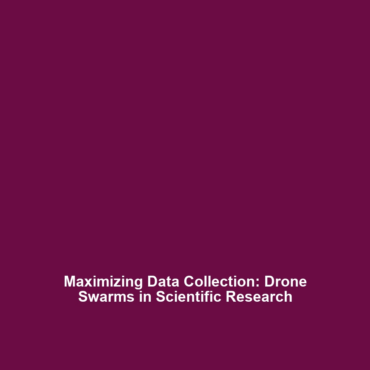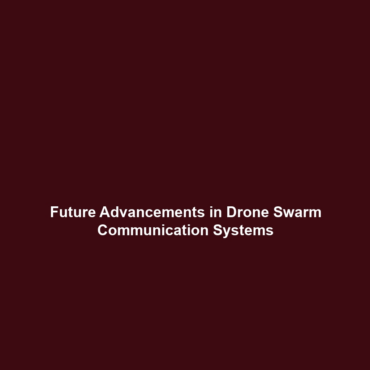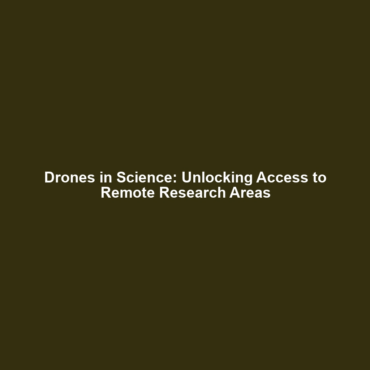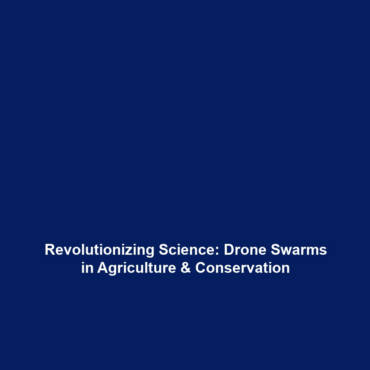The Use of Drone Swarms to Cover Vast Areas and Collect Complex Data Sets in Real Time
Introduction
The advent of drone swarms represents a significant advancement in the field of drones in science. These coordinated fleets of unmanned aerial vehicles (UAVs) are capable of simultaneously covering extensive areas and collecting complex data sets in real time. This technology is not only revolutionizing environmental monitoring but also optimizing agricultural practices, enhancing disaster response efforts, and facilitating wildlife research. As the demand for efficient data collection methods increases, drone swarms are becoming indispensable tools in scientific research and analysis.
Key Concepts
Understanding Drone Swarms
Drone swarms operate on algorithms that mimic natural swarm behavior, allowing them to communicate and collaborate in real-time. Key principles include:
- Distributed Coordination: Each drone in the swarm can operate independently while contributing to the collective goal.
- Real-Time Data Integration: Swarms can aggregate and relay large amounts of data almost instantly, enhancing the speed of information collection.
- Scalability: The number of drones can be easily scaled, allowing for coverage of larger areas without a proportionate increase in manpower.
These concepts highlight how drone swarms fit into the broader context of drones in science by providing tools that increase both accuracy and efficiency in scientific inquiry.
Applications and Real-World Uses
The applications of drone swarms in scientific fields are diverse and impactful. Significant examples include:
- Environmental Monitoring: Drones can survey large regions to monitor air quality, vegetation health, and wildlife populations. Their ability to fly low and collect data quickly makes them ideal for ecosystems that require frequent assessment.
- Agriculture: Farmers use drone swarms to assess crop health, optimize irrigation systems, and manage insect infestations, leading to higher yields and reduced pesticide use.
- Disaster Response: In emergency situations, drone swarms can quickly map affected areas, assess damage, and locate survivors, facilitating faster rescue operations.
These applications demonstrate how drone swarms are used in scientific contexts, showcasing their versatility and effectiveness in data collection.
Current Challenges
Despite the promising potential of drone swarms, several challenges must be addressed:
- Regulatory Hurdles: Many regions have strict regulations regarding UAV operations, which can limit the deployment of drone swarms.
- Data Security: Ensuring the security of the data collected is paramount, especially in sensitive areas such as wildlife conservation.
- Technological Limitations: Battery life and payload capacity remain critical constraints, affecting the duration and range of operations.
- Public Perception: Concerns around privacy and safety can hinder the acceptance of drone technology in various communities.
Addressing these challenges of drone swarms is crucial for maximizing their potential in scientific applications.
Future Research and Innovations
Future innovations in drone swarm technology promise to enhance their effectiveness in scientific applications. Upcoming developments include:
- Enhanced AI Algorithms: Improved decision-making capabilities will allow drone swarms to adapt dynamically to changing environments.
- Longer Range Drones: Breakthroughs in battery technology could significantly extend flight times, enabling coverage of even larger areas.
- Advanced Sensors: New sensor technologies will allow for the collection of a wider variety of data, such as soil health indicators and atmospheric conditions.
These advancements could vastly improve the efficiency and effectiveness of drone swarms in science moving forward.
Conclusion
In conclusion, the use of drone swarms to cover vast areas and collect complex data sets in real time represents a transformative shift in the field of drones in science. From environmental monitoring to disaster response, these technological advancements are paving the way for innovative research methodologies and data collection techniques. As the industry faces and overcomes challenges, ongoing research and future innovations will ensure that drone swarms unlock new opportunities for scientific exploration. Learn more about drones and their scientific applications today!



